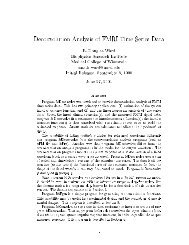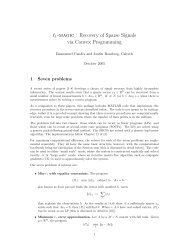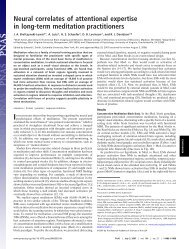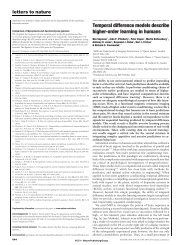The Duchenne Smile: Emotional Expression and Brain Physiology II
The Duchenne Smile: Emotional Expression and Brain Physiology II
The Duchenne Smile: Emotional Expression and Brain Physiology II
Create successful ePaper yourself
Turn your PDF publications into a flip-book with our unique Google optimized e-Paper software.
DUCHENNE SMILE 347Durationof <strong>Smile</strong>s(sec)25201510\PositiveFilmNegativeFilmOther <strong>Smile</strong>s<strong>Duchenne</strong> <strong>Smile</strong>sFigure 3. Mean duration (in seconds) of each type of Duehenne's smile<strong>and</strong> other smiles in response to the positive <strong>and</strong> negative film clips.was 10:1, <strong>and</strong> the ratio of O-smiles during positive as comparedto negative films was 2:45 to I.Did the Type of <strong>Smile</strong> Relate to the SubjectiveExperience of Emotion?Hypothesis 2 predicted that D-smiles but not O-smilingwould be correlated with the subjective experience of positiveemotions. Whereas researchers studying the self-report ofmood (Clark & Watson, 1988; Diener & Emmons, 1984; Stone,1981) have argued against distinguishing among types of positivemoods, we (Ekman, 1977; Ekman & Friesen, 1975) haveargued for making such distinctions among emotions. We agreewith Tomkins (1962) that interest <strong>and</strong> excitement refer to adifferent state than happiness or enjoyment. As Woodworth(1938, p. 411) said, "<strong>The</strong> fact is that there are many kinds ofpleasant feeling, <strong>and</strong> of unpleasant. Some of the words do notindicate whether the feeling is pleasant or unpleasant; excitementmay be happy excitement or unhappy excitement, <strong>and</strong>this is true of expectancy <strong>and</strong> surprise."Although the D-smile may occur with interest <strong>and</strong> excitement,it will only do so in circumstances in which those emotionsblend with or occur in sequence with amusement or happiness.In our experiment interest <strong>and</strong> excitement, if felt, wouldoccur interspersed with amusement <strong>and</strong> happiness. Thus, if D-smiles are correlated with reports of interest <strong>and</strong> excitement, itwould be due to the association of those feelings with amusement<strong>and</strong> happiness.We consider happiness <strong>and</strong> enjoyment as general terms thatcover a variety of different positive emotional experiences suchas sensory pleasure, relief, satisfaction with accomplishment,amusement, <strong>and</strong> contentment. Although we expect that each ofthese positive emotions is experienced differently, with differentsensations <strong>and</strong> physiology, we (Ekman & Friesen, 1982) havehypothesized that all of these positive states share the same expressivesignal--the <strong>Duchenne</strong> smile.Because the positive films shown to the subjects were designedto be amusing, we predicted that D-smiles but not O-smiles would be correlated with reports of either the more specificterm amusement or the more general report of happiness.We did not expect a substantial correlation between D-smiles<strong>and</strong> contentment because these films were not likely to elicitmuch contentment.Table l reports the correlations between the duration of <strong>Duchenne</strong><strong>and</strong> other smiling with each oftbe emotion self-reports.Hypothesis 2 was supported. Only D-smiles, as predicted, werecorrelated with reports of amusement <strong>and</strong> happiness. D-smileswere also positively correlated with excitement <strong>and</strong> interest, althoughthese relationships were not as strong as the correlationsbetween D-smiles <strong>and</strong> amusement or happiness. <strong>The</strong> correlationbetween D-smiles <strong>and</strong> amusement was significantly greaterthan the correlation between D-smiles <strong>and</strong> either excitement(t = 2.49, p < .0 l) or interest (t = 2.22, p < .05, one-tailed tests).<strong>The</strong> correlation between D-smiles <strong>and</strong> happy was significantlygreater than the correlation between D-smiles <strong>and</strong> excitement(t = 1.69,p < .05).Partial correlations showed that the relationships between D-smiles <strong>and</strong> either interest or excitement were, as we predicted,enormously reduced when the variance associated with amusementwas removed. Table 2 shows that when the self-reports ofhappiness or amusement were partialled out, the correlationsbetween D-smiles <strong>and</strong> either interest or excitement disappeared.<strong>The</strong> converse was not so; when the influence of eitherinterest or excitement was partialled out, the correlations betweenD-smiles <strong>and</strong> either amusement or happiness survived.Because amusement <strong>and</strong> happiness ratings were highly correlated(.79 l), we computed partial correlations with D-smiles<strong>and</strong> these two ratings. Table 2 shows that when the influence ofhappiness ratings was controlled, the partial correlation betweenD-smiles <strong>and</strong> amusement was still substantial. However,when the influence of amusement ratings was controlled, thepartial correlation between D-smiles <strong>and</strong> happiness was enormouslyreduced.Table l shows two other findings that were not predicted byHypothesis 2. D-smiles were negatively correlated with reportsof feeling anger <strong>and</strong> sadness, <strong>and</strong> O-smiles were positively correlatedwith the report of disgust.Hypothesis 3 predicted that D-smiles but not O-smiles wouldpredict during which of the two positive films a subject had reportedfeeling most amused <strong>and</strong> most happy. This is a difficultdiscrimination because both the puppy <strong>and</strong> the primate filmshad evoked ratings that were at or very close to the median on



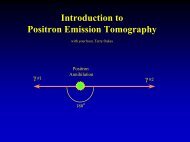
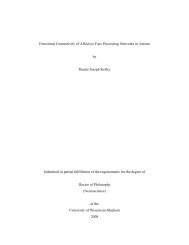
![[F-18]-L-DOPA PET scan shows loss of dopaminergic neurons](https://img.yumpu.com/41721684/1/190x146/f-18-l-dopa-pet-scan-shows-loss-of-dopaminergic-neurons.jpg?quality=85)
